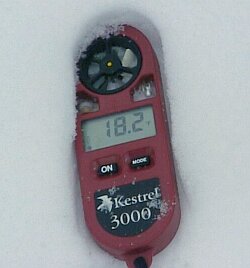First, I'll admit it -- I'm a gadget man. And the Kestrel
3000 is one cool little gadget, especially for a cross-country
skier. The unit is much lighter than I expected from looking
at the photos. It weighs about the same as a small single
bar of wax. The dimensions even remind me of a wax bar: very
similar in length and thickness to a bar of Rex Blue.
The first trick in using the unit: how to remove the plastic
coverslip. The markings on the side, and in the instructions,
imply you're to grab the sides with your fingers and pull
apart. However, I didn't have a lot of luck opening it this
way at first. Instead, there is a little thread-hole on
the bottom of the unit for the neckcord. If you hold the
cover and push on this thread-hole, the unit pops out easily.
And with gloves on, this is really a lot easier than the
other way.
Operating the unit is a lot like any cycling computer.
A single button toggles the unit on and off. The second
button cycles the unit through its various measurement readings.
On the Kestrel 3000, the measurements are: wind speed, max
wind speed (3 second gust since powered on), average wind
speed (since powered on), temperature, wind chill, relative
humidity, heat index, and dew point. Little icons on the
bottom of the LCD display make it easy to recognize the
mode. You can toggle the tempature and wind chill readings
between degrees fahrenheit and degrees centrigrade. The
wind speed readings can also be displayed in a number of
different units.
The meter has external temperature and humidity sensors.
This feature has two big benefits. First, you can get an
accurate temperature reading, even when going from a heated
place to cold outdoor temperatures, by simply waving the
unit in the air (to ensure it measures the air temperature,
not the possible heat from the case). Second, the unit can
be placed in the snow to get a snow temperature reading
(the humidity sensor doesn't like this, though).
 Testing it out:
Testing it out:
I've used the meter now on a number of occasions. In fact,
I almost always have it with me. The unit is so small and
light I just don't notice it.
The first big test of the unit was at the Governor's Cup
race in early February. I was out shooting video on the
course and took some readings, mainly of air and snow temperatures.
I was surprised to find that while the air temperature was
about 14F, the snow temperature was much warmer, at just
over 20F. It had snowed the night before and there was a
nice, light, fluffy 2-3" on the trails.
The next big test for the unit was at the Minnesota State
High School League Nordic Championships. In fact, the unit
turned out to be very useful on this day. The skiers awoke
to some very cold temperatures and dangerous wind chills
(approaching -20F). I spent a good part of the morning taking
air and wind chill readings with the unit and reporting
back to some of the coaches. The stadium area at Giants
Ridge is pretty exposed and had wind chills averaging around
-8F to -12F. But in the woods, where most of the race course
flows, the winds were much calmer, and wind chills ran in
the single digits below zero. Based in part on some of the
readings from this unit, they decided proceed with the state
meet that day rather than having to reschedule it for a
later date.
Most recently, I used the unit at the Birkie in late February.
They received between 3-6" of snow overnight, and it was
still coming down at times during the wave starts. I was
able to get some quick readings before the start of the
elite wave: 21F air temperature, 22F snow temperature.
Summary:
Overall, I've been extremely pleased with the unit. It is
very well designed, with controls that are easy to operate
even with gloves on. The coverslip case quickly protects
the entire unit, but slides out of the way when you're using
the meter. The external sensors are a big plus, allowing
readings in seconds instead of minutes. And it even powers
itself off after 30 minutes of inactivity. If you're spending
much time outside, this is one great gadget!
Thanks to Nielsen-Kellerman
for supplying us with the Kestrel 3000 units. More details
and online ordering for the Kestrel
3000.



